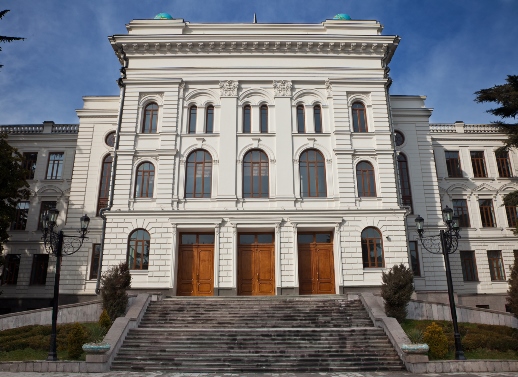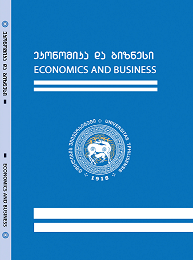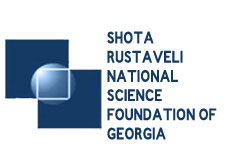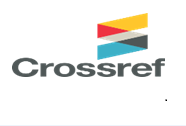
Referential and Reviewed International Scientific-Analytical Journal of Ivane Javakhishvili Tbilisi State University, Faculty of Economics and Business

The Impact of Social Media on Consumers Purchase Decisions for Travel Services (A Study Using the Technology Acceptance Model)
doi.org/10.52340/eab.2024.16.03.09
the 21st century, the rapid development of digital technologies has fundamentally transformed all aspects of our lives, which is why companies, for the most part, have switched to electronic information services. In this case, a special role is assigned to social media, which influences the behavior of tourists. Indeed, social media is a digital platform that allows users to interactively create and share different topics, opinions and experiences with each other.
Today, companies use social media to create successful branding strategies and develop diverse channels of communication with consumers.At the modern stage, social media has become an integral part of the tourism industry, and it plays an important role in consumers' selection of destinations. Social media platforms allow consumers to find concise and relevant information related to tourism. However, each consumer has a specific desire and intention to control their travel experience, which social media helps them do. Social media has increased the ability of people to share their travel experiences with a wider audience than ever before. Accordingly, social media has become a contributing factor in promoting tourism, interacting with tourism service providers, and receiving customer feedback. In addition, social media offers organizations engaged in destination marketing tools that help them maximize target audiences with limited resources.
The tourism industry in Georgia has been developing rapidly in recent years. In Georgia, like other countries, the development of the tourism sector is facilitated by the information spread by travellers and service providers on social media. Despite the wide distribution of social media in the tourism industry of Georgia, the peculiarities of consumer behavior in this area have not been studied much. The issues to be studied in this direction are still relevant. Based on this, the aim of this study is to study the attitude of consumers towards the use of social media marketing in the field of tourism in Georgia. For this, marketing research was conducted. The paper is based on the Technology Acceptance Model (TAM), which is the most influential and widespread theory. TAM is widely used to determine consumer adoption of online platforms for travel and their impact on tourist behavior.
The article discusses the impact of digital technologies on the tourism industry. Special attention is paid to social media, which influences the behavior of users of tourism services. The paper's methodological basis is the Technology Acceptance Model, which helps us study Georgian consumers' attitudes to the information posted on social media by tourist destinations. Based on the literature analysis, research variables (perceived ease, perceived usefulness, attitude towards use, behavioral intention and purchase decision) are identified. Relevant research hypotheses and research conceptual model have been developed. The data was collected using an online survey method. The quantitative research method is used in the paper. For the study of the general community, we used the sampling method. The research area was represented by Georgia, and we made the selection in such a way that it was representative. The target general population of the research is the number of social media users in Georgia. Assuming a 95% confidence level and a 5% margin of error, the sample size was determined to be 608 people.
Since the purpose of the research is to gain knowledge about the impact of social media on purchasing decisions about tourism services and to generalize these results to the selected target group, the quantitative method is the best for this. Based on the set objective, To test research hypotheses, the paper uses a structured questionnaire that includes questions about the respondent's profile and constructs. Correlation and regression analysis methods are used for data processing. Dependencies between the variables named above are established. As a result of the analysis, statistically significant values were obtained, which confirms the reliability of the provisions used in the study and proves the established hypotheses.
The present study provides extensive information about the influence of social media on tourism consumers in Georgia. Our research has shown that Georgian consumers show special interest in tourist destinations and use social media more and more often. Correlational and regression analyses revealed that tourists' perceived ease and perceived usefulness of using social media are positively related to their attitudes toward social media. In turn, social media attitudes influence their downstream intention, which in turn affects destination decision-making. As a result of analyzing the results of the research, statistically significant values were obtained, which reflect the relationships between the above-mentioned variables.
The results of the study confirmed the importance of a number of insights presented in the literature review that tourism organizations should take into account in order to exploit their opportunities. The research revealed that the variables we selected are relevant to tourism customer relationships. It should be noted that the results of our study confirm the existing literature in terms of the influence of social media on tourist behavior. Therefore, the results of the study have theoretical significance in terms of the use of social media as a marketing communication tool in tourism. Companies can use these results to effectively interact with customers and promote their marketing strategies through social media. The practical implementation of the research results will help managers working in the tourism industry expand their understanding of social media and actively use it to attract the target audience.
In addition, we should mention that several limitations were considered when conducting the research. The study mainly focused on the 18-35 age group, which cannot be considered as the entire population, however, the largest share of the number of social media users comes from this age group. Although residents of different regions of Georgia took part in the research, the research was mostly based on a survey of consumers in the capital city (Tbilisi). Such a restriction was based on the fact that the largest part of Georgian residents and, therefore, social media users come to Tbilisi. With further studies, it is advisable to expand the sample size to include a diverse audience from different regions of the country. In addition, qualitative research methods can be incorporated into the study to analyze in more depth the specific mechanisms through which social media influence tourism consumer behavior.
References:
• Agyapong E., & Yuan J. (2022). Social Media Impact on Tourism Destination Decision: Evidence from International Students in China. Open Journal of Applied Sciences, 12(12), 2055-2080.
• Ajzen I., & Fishbein M. (1977). Attitude-Behavior Relations: A Theoretical Analysis and Review of Empirical Research. Psychological Bulletin, 84(5), 888.
• Alt R., & Klein S. (2011). Twenty Jears of Electronic Markets Research—Looking Backwards Towards the Future. Electronic Markets, 21, 41-51.
• Altınay M., Güçer E., & Bağ C. (2017). Consumer Behavior in the Process of Purchasing Tourism Product in Social Media. Journal of Business Research-Turk, 9(1), 381-402.
• Arowosafe F., Akinwotu O., Tunde-Ajayi O., Omosehin O., & Osabuohien E. (2022). Push and Pull Motivation Factors: a Panacea for Tourism Development Challenges in Oluminrin Waterfalls, Nigeria. Journal of Policy Research in Tourism, Leisure, and Events, 14(1), 63–74.
• Berakon I., Wibowo M. G., Nurdany A., & Aji H. M. (2023). An Expansion of the Technology Acceptance Model Applied to the Halal Tourism Sector. Journal of Islamic Marketing, 14(1), 289-316.
• Camilleri M. A., & Kozak M. (2022). Interactive Engagement Through Travel and Tourism Social Media Groups: A Social Facilitation Theory Perspective. Technology in Society, 71, 102098.
• Carlisle S., Ivanov S., & Dijkmans C. (2023). The Digital Skills Divide: Evidence from the European Tourism Industry. Journal of Tourism Futures, 9(2), 240-266.
• Chen X., & Zhang H. (2015). Current Status and Review of Tourism Application Research on Social Media. Tour. Trib, 46, 38-46.
• Chen M. F., & Tung P. J. (2014). Developing an Extended Theory of Planned Behavior Model to Predict Consumers’ Intention to Visit Green Hotels. International Journal of Hospitality Management, 36, 221-230.
• Chen S., Law R., Zhang M., & Si Y. (2021). Mobile Communications for Tourism and Hospitality: A Review of Historical Evolution, Present Status, and Future Trends. Electronics, 10(15), 1804.
• Chen Y. C., Shang R. A., & Li M. J. (2014). The Effects of Perceived Relevance of Travel Blogs’ Content on the Behavioral Intention to Visit a Tourist Destination. Computers in Human Behavior, 30, 787–799.
• Chin W. W., & Todd P. A. (1995). On the Use, Usefulness, and Ease of Use of Structural Equation Modeling in MIS Research: A note of Caution. MIS quarterly, 237-246.
• Corrêa S. C. H., & Gosling M. D. S. (2021). Travelers’ Perception of Smart Tourism Experiences in Smart Tourism Destinations. Tourism Planning & Development, 18(4), 415-434.
• Dai L., Toanoglou M., & Zhang B. (2021). The Impact of Social Media on Travel Intentions of International Students: The Evidence of an Empirical Study from China. International Journal of Tourism Management and Sciences, 36(3), 103–128.
• Datareportal. (2024). Digital 2024: Georgia. Retrieved from: https://datareportal.com/reports/digital-2024-georgia#:~:text=The%20state%20of%20digital%20in%20Georgia%20in%202024&text=Georgia%20was%20home%20to%202.85,percent%20of%20the%20total%20population.
• Davis F. D. (1989). Perceived Usefulness, Perceived Ease of Use, and User Acceptance of Information Technology. MIS Quarterly, 319-340.
• Dirgayasa I. M., & Darma G. S. (2024). Analyzing the Impact of Social Media Marketing, Green Marketing, and Developer Reputation on Property Purchase Intention. Journal of Ecohumanism, 3(4), 1250-1260.
• Fotis J., Buhalis D., & Rossides N. (2012). Social Media Use and Impact During the Holiday Travel Planning Process. In Information and Communication Technologies in Tourism 2012 (pp. 13-24). Springer, Vienna.
• Geostat (2023). Tourism Statistics. Retrieved from: https://www.geostat.ge/ka/modules/categories/100/turizmis-statistika
• Han H., Hwang J., Lee M. J., & Kim J. (2019). Word-of-mouth, Buying, and Sacrifice Intentions for Eco-cruises: Exploring the Function of Norm Activation and Value-attitude-behavior. Tourism Management, 70, 430-443.
• Hanaysha J. R. (2022). Impact of Social Media Marketing Features on Consumer's Purchase Decision in the Fast-food Industry: Brand Trust as a Mediator. International Journal of Information Management Data Insights, 2(2), 100102.
• Heslop L. A., Papadopoulos N., & Bourk M. (1998). An Interregional and Intercultural Perspective on Subcultural Differences in Product Evaluations. Canadian Journal of Administrative Sciences/Revue Canadienne des Sciences de l'Administration, 15(2), 113-127.
• Hou Z., Cui F., Meng Y., Lian T., & Yu C. (2019). Opinion Mining from Online Travel Reviews: A Comparative Analysis of Chinese Major OTAs Using Semantic Association Analysis. Tourism Management, 74, 276-289.
• Hu Y., & Kim H. J. (2018). Positive and Negative eWOM Motivations and Hotel Customers’ eWOM Behavior: Does Personality Matter? International Journal of Hospitality Management, 75, 27-37.
• Hua C., Bai C., & Wei M. (2019). The Impact of Mobile Tourism Information Service Experience on Travel Decision Quality. Tourism Tribune, 34(11), 51-65.
• Hua L. Y., Ramayah T., Ping T. A., & Jun-Hwa C. (2017). Social Media as a Tool to Help Select Tourism Destinations: The Case of Malaysia. Information Systems Management, 34(3), 265-279.
• Hur K., Kim T. T., Karatepe O. M., & Lee G. (2017). An Exploration of the Factors Influencing Social Media Continuance Usage and Information Sharing Intentions among Korean Travellers. Tourism Management, 63, 170-178.
• Hussain T., Wang D., & Li B. (2024). Exploring the Impact of Social Media on Tourist Behavior in Rural Mountain Tourism during the COVID-19 Pandemic: The Role of Perceived Risk and Community Participation. Acta Psychologica, 242, 104113.
• Jashi C. (2013, November). Significance of Social Media Marketing in Tourism. In 8th Silk Road International Conference “Development of Tourism in Black and Caspian Seas Region”. Tbilisi: Black Sea University Publishing, 37-42.
• Jia Yanju. (2017). Research Progress on Tourist Behavior in the Era of Social Media: a Carding Based on Foreign Literature. Tourism Tribune, (4), 117-126.
• Keelson S. A., Bruce E., Egala S. B., Amoah J., & Bashiru Jibril A. (2024). Driving Forces of Social Media and Its Impact on Tourists’ Destination Decisions: a Uses and Gratification Theory. Cogent Social Sciences, 10(1), 2318878.
• Khan O., Bellini N., Daddi T., & Iraldo F. (2022). Effects of Behavioral Intention and Dynamic Capabilities on Circular Economy Adoption and Performance of Tourism SMEs. Journal of Sustainable Tourism, 31(8), 1777–1796.
• Kim D. Y., Park J., & Morrison A. M. (2010). A Model of Traveler Acceptance of Mobile Technology. International Journal of Tourism Research, 10(5), 393-407.
• Kim J. S. (2016). An Extended Technology Acceptance Model in Behavioral Intention toward Hotel Tablet Apps with Moderating Effects of Gender and Age. International Journal of Contemporary Hospitality Management, 28(8), 1535–1553.
• Krakover S., & Corsale A. (2021). Sieving Tourism Destinations: Decision-Making Processes and Destination Choice Implications. Journal of Tourism, Heritage & Services Marketing (JTHSM), 7(1), 33-43.
• Krejcie R. V., & Morgan D. W. (1970). Determining Sample Size for Research Activities. Educational and Psychological Measurement, 30(3), 607-610.
• Kumar S., & Singh B. (2023). What Drives Students to Adopt M-learning Apps? The Role of e-WOM in Signalling Theory Perspective. Behaviour & Information Technology, 42(12), 2042-2059.
• Kyriakaki A., Stavrinoudis T., & Daskalopoulou G. (2020). Investigating the Key Factors Influencing the International Tourists’ Decision-Making on Choosing a Destination. In: Katsoni V., Spyriadis T., Eds., Cultural and Tourism Innovation in the Digital Era. Springer Proceedings in Business and Economics. Springer, Cham, 335–352.
• Lee C. T., & Hsieh S. H. (2022). Can Social Media-Based Brand Communities Build Brand Relationships? Examining the Effect of Community Engagement on Brand Love. Behaviour & Information Technology, 41(6), 1270-1285.
• Lee Y. H., Hsieh Y. C., & Hsu C. N. (2011). Adding Innovation Diffusion Theory to the Technology Acceptance Model: Supporting Employees' Intentions to Use e-Learning Systems. Journal of Educational Technology & Society, 14(4), 124-137.
• Leelawat N., Jariyapongpaiboon S., Promjun A., Boonyarak S., Saengtabtim K., Laosunthara A., ... & Tang, J. (2022). Twitter Data Sentiment Analysis of Tourism in Thailand during the COVID-19 Pandemic Using Machine Learning. Heliyon, 8(10), e10894.
• Li F., Larimo J., & Leonidou L. C. (2021). Social Media Marketing Strategy: Definition, Conceptualization, Taxonomy, Validation, and Future Agenda. Journal of the Academy of Marketing Science, 49, 51-70.
• Li F., Larimo J., & Leonidou L. C. (2023). Social Media in Marketing Research: Theoretical Bases, Methodological Aspects, and Thematic Focus. Psychology & Marketing, 40(1), 124-145.
• Lim W.M., & Weissmann M. A. (2023). Toward a Theory of Behavioral Control. Journal of Strategic Marketing, 31(1), 185-211.
• Lu J. L., & Wang C. Y. (2018). Investigating the Impacts of Air Travellers’ Environmental Knowledge on Attitudes Toward Carbon Offsetting and Willingness to Mitigate the Environmental Impacts of Aviation. Transportation Research Part D: Transport and Environment, 59, 96-107.
• Mainardes E. W., & Cardoso M. V. (2019). Effect of the use of social media in trust, loyalty and purchase intention in physical stores. The International Review of Retail, Distribution and Consumer Research, 29(4), 456-477.
• Malhotra N. (2020). Marketing Research: An Applied Orientation. 7th ed., London: Pearson Education Limited.
• Mandasari V. (2021). Tourists’ Decision Making in Choosing Destination Place. Journal of Economics, Finance and Management Studies, 4, 1974-1980.
• Matin M., & Laksamana P. (2023). Analysis of the Influence of Mobile Marketing and Social Media Marketing on Purchase Intention with Customer Engagement as an Intervening Variable in the Property Industry. Journal of Social Research, 2(5), 1765-1773.
• Nguyen T. T. T., & Tong S. (2022). The Impact of User-Generated Content on Iintention to Select a Travel Destination. Journal of Marketing Analytics, 11(3), 443–457.
• Nunnally J.C. (1967). Psychometric Theory. New York, NY: McGraw-Hill Book Company.
• Nzeku B., & Duffett R. G. (2021). The Use of Social Media as a Marketing Tool by Tourist Attractions: Influence on Cognitive, Affective and Behavioural Consumer Attitudes. African Journal of Hospitality, Tourism and Leisure. 10(2), 742-758.
• Oliveira T., Araujo B., & Tam C. (2020). Why do People Share Their Travel Experiences on Social Media? Tourism Management, 78, 104041.
• Oliver R. L. (1980). A Cognitive Model of the Antecedents and Consequences of Satisfaction Decisions. Journal of marketing research, 17(4), 460-469.
• Roslina R., & Mahrinasari M. (2023). Influence of E-Service Quality, E-Trust, E-Satisfaction, and E-WOM on Repurchase Intention at Travel Media Online (Traveloka) in Indonesia. Journal of Economics, Finance and Management Studies, 6(19), 4869-4878.
• Senyao S., & Ha S. (2022). How Social Media Influences Resident Participation in Rural Tourism Development: A Case Study of Tunda in Tibet. Journal of Tourism and Cultural Change, 20(3), 386-405.
• Septianto F., & Chiew T. M. (2018). The Effects of Different, Discrete Positive Emotions on Electronic Word-of-Mouth. Journal of Retailing and Consumer Services, 44, 1-10.
• Seturi M., & Urotadze E. (2020). Some Opinions About Sustainable Development and Tourism (Case of Georgia). In Strategic Imperatives of Modern Management (Kyiv National Economic University named after Vadym Hetman), 286-289.
• Shan S., Ren J., & Li C. (2017). The Dynamic Evolution of Social Ties and User-Generated Content: A Case Study on a Douban group. Enterprise Information Systems, 11(10), 1462-1480.
• Statista. (2024). Number of Internet and Social Media Users Worldwide as of January 2024 (in billions)“. Retrieved from: https://www.statista.com/statistics/617136/digital-population-worldwide/
• Sultan M. T., Sharmin F., & Xue K. (2019). Sharing Tourism Experience through Social Media: Consumer’s Behavioral Intention for Destination choice. International Journal of Humanities and Social Sciences, 13(2), 141–145.
• Surendran P. (2012). Technology Acceptance Model: A Survey of Literature. International Journal of Business and Social Research, 2(4), 175-178.
• Taylor S., & Todd P. (1995). Assessing IT Usage: The Role of Prior Experience. MIS Quarterly, 561-570.
• Tešin A., Pivac T., Besermenji S., & Obradović S. (2022). Exploring the Influence of Instagram on Travel Destination Choice. The European Journal of Applied Economics, 19(1), 66-80.
• Tham A., Mair J., & Croy G. (2020). Social Media Influence on Tourists’ Destination Choice: Importance of Context. Tourism Recreation Research, 45(2), 161-175.
• Todua N. (2017). Social Media Marketing for Promoting Tourism Industry in Georgia. In 22nd International Conference on Corporate and Marketing Communications: Challenges of Marketing Communications in a Globalized World (Zaragoza, Spain) 168-171.
• Todua N., & Urotadze E. (2022). The Effect of Social Media Marketing on Consumer Behavior of Tourism Destinations. Strategic Planning and Marketing in the Digital World. Edition: University of National and World Economy (Sofia). Publishing Complex UNWE, 123-133.
• Todua N. (2019). Using Social Media Marketing for Attracting Foreign Tourists to Georgian Destinations. Globalization and Business, 4(7), 39-48.
• Tsiakali K. (2018). User-Generated-Content Versus Marketing-Generated-Content: Personality and Content Influence on Traveler’s Behavior. Journal of Hospitality Marketing & Management, 27(8), 946-972.
• Van der Heijden H. (2003). Factors Influencing the Usage of Websites: the Case of a Generic Portal in The Netherlands. Information & Management, 40(6), 541-549.
• Venkatesh V., & Davis F. D. (2000). A Theoretical Extension of the Technology Acceptance Model: Four Longitudinal Field Studies. Management Science, 46(2), 186-204.
• Wallace L. G., & Sheetz S. D. (2014). The Adoption of Software Measures: A Technology Acceptance Model (TAM) Perspective. Information & Management, 51(2), 249-259.
• Walsh, P. R., & Dodds, R. (2022). The Impact of Intermediaries and Social Marketing on Promoting Sustainable Behaviour in Leisure Travellers. Journal of Cleaner Production, 338, 130537.
• Wang H., & Yan J. (2022). Effects of Social Media Tourism Information Quality on Destination Travel Intention: Mediation Effect of Self-Congruity and Trust. Frontiers in Psychology, 13, 1049149.
• Wang Y. S., Wu S. C., Lin H. H., Wang Y. M., & He T. R. (2012). Determinants of User Adoption of Web''Automatic Teller Machines': an Integrated Model of' Transaction Cost Theory'and'Innovation Diffusion Theory'. The Service Industries Journal, 32(9), 1505-1525.
• Wei C. F., Cheng Y. Y., Chiang C. T., & Ding G. H. (2020). What Drives Social Media Relationship Quality in Social Enterprises. Journal of Marketing Management, 8(1), 37-49.
• WinSavvy. (2024). Social Media and Tourism: Key Statistics for 2024. Retrieved from: https://www.winsavvy.com/social-media-and-tourism-key-statistics/
• Xiang Z., & Gretzel U. (2010). Role of Social Media in Online Travel Information Search. Tourism Management, 31(2), 179-188.
• Zandi S. (2023). Revival of the Silk Road Using the Applications of AR/VR and its Role on Cultural Tourism. Preprint Arxiv:2304.10545.
• Zeng B., & Gerritsen R. (2014). What do we Know About Social Media in Tourism? A Review. Tourism Management Perspectives, 10, 27-36.
Keywords: Social media, tourism service, consumer behavior, marketing research.
JEL Codes: L82, L83, M31









